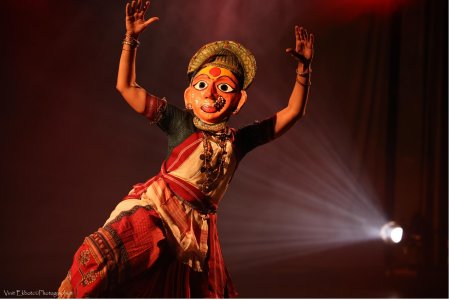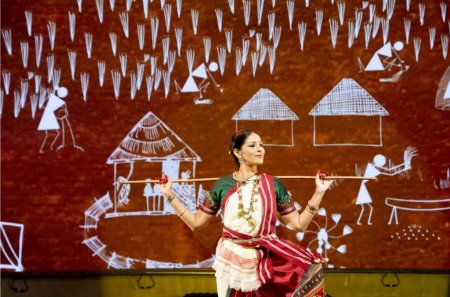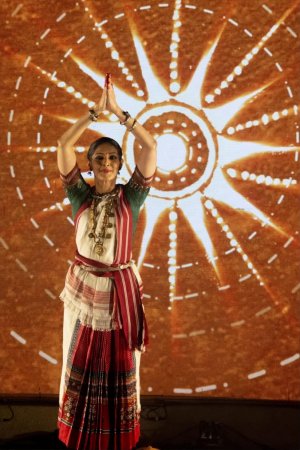
|   |

|   |
When Walls Dance - Chandra Anand e-mail: chandra6267@yahoo.co.in Photos: Jimeet Pawaskar July 18, 2024 'When walls dance', a short production created by Prachi Saathi and Upasana Nattonji Roy, was presented at The Studio, NMCCA, BKC, Mumbai, on June 14, 2024. This presentation is where three art forms of dance, animation and music are entwined to present a simple story. It was an appropriate and fortuitous amalgamation of the art of classical dance form Bharatanatyam with art of Warli drawings through animation and exposition of the folk cultural traditions of the Warli people along with their indigenous dance and music. The presentation was a simple concept but having many layers. One, it used the art form of Bharatanatyam to present a short story of a little girl Champa. Through the depiction of the events that happen in her life, we come to know the life and culture of the Warli people living in the Warli village at Jawahar, Maharashtra. Through this presentation the audience gets a feel of their attitude towards life and their connection with the natural environment around them. And one gets to see the beauty of the Warli paintings as it is used as visual imagery to support the story presented by the dancer. The spark of the origins of this production happened to be in an identification of a similarity to the drawings of the choreography notes of korvais and jathis made with stick drawings to the Warli drawings of the Warli people. Taking this inquisition forward, led to getting in hand researched pages, in which the life of the Warli people was made known. An understanding of the ethos of their life was imbibed. Thus, an idea to present through the medium of art, their cultural values and the drawings that they drew with paint, was formed. So a tryout of assimilating their rituals that connect to nature and the lifestyle of the Warli people and their indigenous art of dance, music, drawing and painting into an artistic presentation was carried out.  The presentation started by paying homage to Devi, the Ultimate being for the Warli community by Prachi. Praying to the Goddess requesting her to bequeath her blessing and protection of the people was done in Bharatanatyam idiom. She wore a mask of The Goddess and enacted Devi's benign and ferocious forms in live dance. This mask represented the Bohada, a mask festival of the Warli tribes, which is celebrated to invoke the rain gods to ensure a good crop in the season and to pay homage to village Gods and Goddesses for the creation and sustaining of life. In the latter part of the presentation, the mask of monkey and lion too were used to showcase this art.  Prachi progressed to Alarippu where she incorporated the farming procedures and the cattle rearing techniques of the Warli community in the Alarippu structure. The idea of blossoming here was used to show how a day unfolds in the Warli village. As the dance performance was being carried out on stage, in the background curtain was shown an animated version of the presentation in Warli drawings and paintings. Thus we find a jugalbandi of the art forms of Bharatanatyam and Warli drawings through animation.  The production depicted the simple story of a little girl and her relationship with the Champa flower tree. According to the culture and traditions of the Warli people, when a child is born, a tree sapling is planted to mark the auspiciousness of the event. Here this little girl named Champa falls in love with the tree planted when she was born. She feels proud that the tree is named after her. After she grows a bit, she realizes it was actually the other way round. She makes the Champa tree her confidante and confides to it about all experiences she undergoes in day to day life. The growth of the girl and the sapling into a tree is depicted by live dance and visual images in animation. Thus we have alphabet song, marriage song, the bird song and rain song. The rain song depicted the celebration that comes with the arrival of rain. Here the sync between live dance and animation captivates the visual senses. Clouds forming shapes, river flowing in abundance, water making puddles, crops swaying in the air and dancing peacocks creates a feeling of freshness and joy that rainy season brings to earth. Finally, the time comes when Champa is ready to be married. A boy is chosen and a day for marriage is fixed for her. Champa realizes it's time to move away from the tree. She is broken hearted at the aspect but goes away with the promise to visit often. The activities and rituals of the marriage ceremony are shown in detail through live dance as well as animation. The Warli people paint the "lagnachauk," an auspicious Warli painting which has great spiritual significance. It frames the Palghat Devi who is the goddess of fertility and is invoked to bring good fortune to the newly wedded couple.  Champa now gets acquainted with her new house and its duties. Then comes Vasant Panchami, an opportunity to see her tree avails her. Their reunion is represented here with a Tillana, an expression of joy and happiness. But on getting back to her village she sees that all the trees in her village are being cut to make way for buildings and factories. She tries to protect the tree. But alas it gets cut down and she falls down feeling very upset, a small tragedy that touched the hearts of one and all viewing this presentation. Thus 'When walls dance' is a good example of showing the ethos of a culture which is associated with nature environment and about respecting the values of the tribe and its indigenous arts. The jugalbandi of the arts of live dance of Bharatanatyam and visual imagery of the Warli art gave an immersive experience. It stood as a holistic presentation each art merging with the other. Thus perhaps has arrived another medium of art presentation. Perhaps can say technology which is now part of our lives can be now used to create art with aesthetic value too. But this type of art is restricted to the auditoriums that can afford and provide the necessary equipment to showcase the production. The program seemed to have a margam presentation order with inclusion of invocation song, alarippu, the birth of the girl as the sabdam, the growing up years as the varnam, the rain song and bohada act can be versions of the kirtanam ending with the thillana, an item of joy leading towards the climax of rasa. Here the rasa is shoka rasa giving us an indepth understanding of how life has moved away from nature. Urbanization is actually destroying our ecosystem. Giving a short review over a video chat, renowned Manipuri exponent Guru Darshana Jhaveri said, "'When walls dance' is a unique concept by Prachi Saathi. She has woven beautifully classical and folk traditions of dance, music, painting to convey a simple story effectively in a beautiful presentation using modern stage technology appealing to different levels of audiences. A production worth watching!"  Chandra Anand is a Bharatanatyam artiste and teacher. She has an MA in Bharatanatyam from Tilak Maharashtra Vidyapeeth, and her series on 'Education in spiritual values through Bharatanatyam' is featured in narthaki.com. |